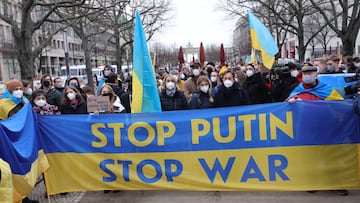What are Russian-backed separatists?
The Donbas region of Eastern Ukraine appears to be the target of a Russian invasion after President Putin officially recognised the independence of Donetsk and Luhansk.


On Monday President Vladimir Putin announced that Russia had officially recognised two breakaway regions of eastern Ukraine as independent, fuelling fears that a full-scale invasion was imminent.
The two regions, Donetsk and Luhansk, lie along the border with Russia and have been in the control of Russian-backed separatist groups for years.
Reuters reports that columns of military vehicles were seen travelling through Donetsk in the early hours of Tuesday morning. The movement of military personnel and vehicles, which included at least five tanks, is thought to be related to Putin’s recognition of the two regions.
Russia is thinking of “recognition” of “LPR/DPR” within the boundaries not of the occupied territory, but of entire Luhansk & Donetsk regions. This would expand the aggression to the entire Donbas. On the map you see the occupied territory & the whole regions marked with 🇺🇦 pic.twitter.com/ZbnFi54vE0
— Iuliia Mendel (@IuliiaMendel) February 22, 2022
Why have Donetsk and Luhansk declared themselves independent from Ukraine?
Russia and Ukraine were the two largest nations to form after the fall of the Soviet Union in the early 1990s and areas on the border between the two share many cultural, social and historical similarities.
A region known as Donbas, which is comprised of Donetsk and Luhansk, broke from the Ukraine’ government control in 2014 when Russia annexed Crimea and declared themselves “people’s republics.”
Until Putin’s announcement on Monday, no nations had recognised their independence from Ukraine but Russia had supported the separatists to ensure that they were able to function away from Ukrainian control.
Follow all the latest breaking news...
Russia has given separatist forces in the region access to covert military support, financial aid and has issued more than 800,000 Russian passports to residents living in the area. This effort appears designed to help shift the Donbas region closer to Russia and away from the control of Ukraine.
Russia had previously denied that it was planning to enter the region but Putin's ambitions in relation to Ukraine have been reported on for decades and in his speech on Monday he was eager to emphasise similarities between the two nations.
What does this mean for the conflict on the Ukrainian border?
Putin’s remarks in recent days show a marked departure from previous rhetoric, explicitly saying that Russia no longer considers Donbas to be a part of Ukraine. This was perhaps the clearest sign yet of Putin laying the preparations for invasion, allowing Russia to claim that entry into the region does not encroach on Ukrainian territory.
Russian troops entered the Donbas region of eastern Ukraine, the EU’s foreign policy chief said, although he stopped short of calling it an invasion.
— The New York Times (@nytimes) February 22, 2022
“I wouldn’t say it is a fully fledged invasion,” he said, “but Russian troops are on Ukrainian soil.”https://t.co/EDGENHw0Az
The Kremlin has repeatedly claimed that Russian forces are active in the region on a “peacekeeping” mission but there is little to stop them and Donbas separatists from pushing further into Ukrainian land. In fact, during his hour-long speech on Monday, Putin argued the area in Eastern Ukraine is "ancient Russian lands".
Related stories
Putin’s move can only be seen as deliberately provocative and one that gives little doubt as to his ambitions in the region. After weeks of insisting that the roughly 180,000 troops amassed along the Ukrainian border were there to conduct training exercises, the sight of tanks rolling into Ukraine makes clear that the sanctions offered up by Western powers so far have not had the desired effect.
It remains to be seen whether Russia’s support of separatists in Ukraine is simply intended to secure the Donbas region for Putin, or whether it heralds the start of a new spell of Russian expansionism in Eastern Europe.

